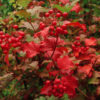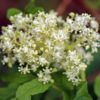American Redbud (Cercis canadensis)
$6.00
Redbud trees produce beautiful edible flowers early in spring that can be added to salads or used as a garnish. They have a flavor similar to snow peas and are thought to have health benefits similar to those in red wine (think bioflavonoids and anti-oxidants). The trees also serve as a host plant to the larvae to several butterflies and moths.
From Oikos on the origin of this strain:
“Starting in the early 90’s I found an old Alba tree here in southwest Michigan which Icollected seeds from. They did not turn out true to fl ower color but did produce much larger and robust trees with largerleaves than the native Michigan seed sources we used previously. One tree grew to 45 ft. tall with a wide open vase typetree structure. Others fl owered on small plants when only 4-5 ft. tall. For this reason, we think this mid-western seedsource is a good one including hardiness taking minus 25 F once on the top of our windy hill planting with no winterinjury. The fl ower yield is very high which are produced all along the branches”
Plants are provided in a deep 3″ plastic pot provided by Oikos Nursery. They may be accompanied by native violets that share the pot.
Out of stock
Description
Why are We Planting This?
Ecological Gifts
Loved by pollinators and serves as a host plant (a type of plant critical to the lifecycle of a specific species) to some butterflies and moths
Edible Gifts
Flowers are rich in Vitamin C and can be used in salad, pickled, or as a caper substitute. One report says the flower contains 22.9 – 27.5% protein, 7.7 – 8.8% fat and 3% ash on a zero moisture basis.
Medicinal Gifts
American redbud also has a rich medicinal history. See below.
Other Gifts
These plants are nitrogen fixers and help improve the health of your soil. A type of symbiotic bacterial species loves the roots of these plants. The bacteria take unusable nitrogen in the air and turn it into a form that’s accessible to plants and other lifeforms. We love nitrogen fixing plants and use them strategically around the yard. The bark of Redbuds can also reportedly be used in basketmaking, something we’d like to explore and learn in the future once some willows we’re currently nurturing grow up!
Read more about the ethnobotany of American Redbud and its history of medicinal uses at the fully-referenced Plants for a Future and the Native American Ethnobotany Database.
Additional information
| Type of Plant | Native to Michigan, Open-pollinated Cultivar by Oikos |
|---|---|
| Sun | Full, Partial |
| Soil | Average |
| Height | 12'-25' |
| Bloom Time | May |
| Bloom Color | Pink |
| Native Plant Category | Trees, Shrubs, and Vines |
| Special Features | Edible, Host Plants, Nitrogen Fixer |



